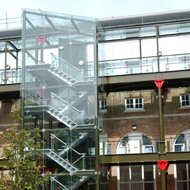Building in Context design programme


Building in Context was published jointly by English Heritage and CABE (the Commission for Architecture and the Built Environment) in 2001. It aims to stimulate a high standard of design when development takes place in historically sensitive contexts. It aims to do this by example, showing a series of case studies in which achievement is far above the ordinary. As a result, it is hoped that people will be encouraged to emulate the commitment and dedication shown by the clients, architects, planning officers and committee members involved in the projects illustrated and be able to learn from their experience.
The belief underlying the publication is that the right approach is to be found in examining the context for any proposed development in great detail and relating the new building to its surroundings through an informed character appraisal. This does not imply that any one architectural approach is, by its nature, more likely to succeed than any other. On the contrary, it means that as soon as the application of a simple formula is attempted a project is likely to fail, whether that formula consists of ‘fitting in’ or ‘contrasting the new with the old’.
A successful project will:
- Relate well to the geography and history of the place and the lie of the land
- Sit happily in the pattern of existing development and routes through and around it
- Respect important views
- Respect the scale of neighbouring buildings
- Use materials and building methods which are as high in quality as those used in existing buildings
- Create new views and juxtapositions which add to the variety and texture of the setting.
The right approach involves a whole process in addition to the work of design, from deciding what is needed, through appointing the architect, to early discussions with and eventual approval by the planning authority.
Collaboration, mutual respect and a shared commitment to the vision embodied in the project will be needed if the outcome is to be successful. The report came to a number of conclusions:
- All successful design solutions depend on allowing time for a thorough site analysis and careful character appraisal of the context
- The best buildings result from the creative dialogue between the architect, client, local planning authority and others; pre-application discussions are essential
- The local planning authority and other consultees can insist upon good architecture and help to achieve it
- Difficult sites should generate good architecture, and are not an excuse for not achieving it
- With skill and care, it is possible to accommodate large modern uses within the grain of historic settings
- High environmental standards can help generate good architecture
- Sensitivity to context and the use of traditional materials are not incompatible with contemporary architecture
- Good design does not stop at the front door, but extends into public areas beyond the building
- High-density housing does not necessarily involve building high or disrupting the urban grain and it can be commercially highly successful
- Successful architecture can be produced either by following precedents closely, by adapting them or by contrasting with them
- In a diverse context a contemporary building may be less visually intrusive than one making a failed attempt to follow historic precedents
The above are extracts from the document, which was written by Francis Golding. The case studies were chosen to cover a wide range of different uses, locations, architectural approaches and processes. Each case study looks at the project as a whole, the site, the problems, the solutions and the lessons learnt.
The full text of Building in Context and its case studies are available on-line from the PDF version of the document.
What's New?
-
The National Heritage List for England is now live on the English Heritage website.
-
Welcome to the HER21 page. This page offers access to the full suite of HER21 project reports.
